Reviewing Program Enrollment Configuration Options
Use the tables below to review all available configuration options which can be submitted as a request using My Oracle Support.
Note: You can use the Opower Configuration Tool to implement certain configurations for Digital Self Service - Transactions. This can include user experience configurations, interface messages and formats, branding configurations, and other configurations relevant to Digital Self Service - Transactions. To review if any configurations listed below are available with the Opower Configuration Tool, access the tool at https://configuration.opower.com/ and review the available options for the pages and widgets included in your Digital Self Service - Transactions web portal.
Manage Billing Configuration Options
The following image shows a standard example of the Manage Billing options that present program enrollment options.
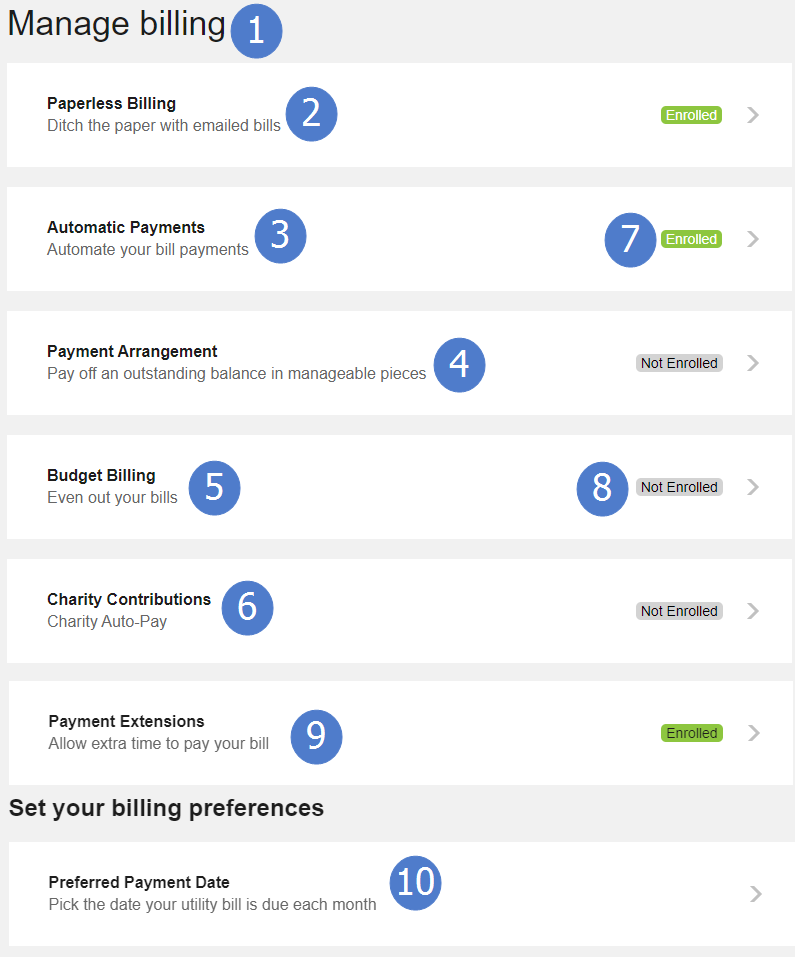
Use the table below to review all available configuration options.
| Image Number | Configuration Option |
|---|---|
| 1 |
Title Default: Manage Billing |
| 2 |
Paperless Billing Title Default: Paperless Billing |
| 2 |
Paperless Billing Description Default: Ditch the paper with emailed bills |
| 3 |
Automatic Payments Title Default: Automatic Payments |
| 3 |
Automatic Payments Description Default: Automate your bill payments |
| 4 |
Payment Arrangement Title Default: Payment Arrangement |
| 4 |
Payment Arrangement Description Default: Pay off an outstanding balance in manageable pieces |
| 5 |
Budget Billing Title Default: Budget Billing |
| 5 |
Budget Billing Description Default: Even out your bills |
| 6 |
Charity Contributions Title Default: Charity Contributions |
| 6 |
Charity Contributions Description Default: Charity Auto-Pay |
| 7 |
Enrolled Status Default: Enrolled |
| 8 |
Not Enrolled Status Default: Not Enrolled |
| 9 |
Payment Extensions Title Default: Payment Extensions |
| 10 |
Preferred Payment Date Title Default: Preferred Payment Date |
| 10 |
Preferred Payment Date Description Default: Pick the date your utility bill is due each month |
Paperless Billing Configuration Options
The following image shows a standard example of Paperless Billing.

Use the table below to review all available configuration options.
| Image Number | Configuration Option |
|---|---|
| Not Depicted |
Disable Paperless Billing Enrollment Paperless billing enrollment can be hidden from Manage Billing Configuration Options if the utility does not want to offer this program to customers. Default: Enable Paperless Billing Enrollment |
| Not Depicted | Bill Route Types
To support paperless billing enrollment, you must provide Oracle Utilities with the bill route types that support paper billing and paperless billing. A bill route type is also required for dual billing if dual bill enrollment is enabled. Provide the bill route type name defined in your system, along with the type of billing enrollment that it supports. Default: None |
| 1 |
Title Default: Paperless Billing |
| 1 |
Explanation Default: Ditch the paper and receive your bills via email. |
| 2 |
How it Works Section Title Default: How it works |
| 2 |
How it Works Description Default: You'll get your bill delivered to your inbox, faster than you would normally receive it in the mail. And if you want a paper copy of your bill, you can always print one out from your online account. |
| 3 |
Enrollment Section Title Default: Send to your primary email address: |
| Not Depicted |
Enable Dual Bill Enrollment Customers can be allowed to enroll in paperless billing while also retaining the option to receive paper bills as well. Customers who enroll in paperless billing then have the option to remain enrolled in paper bills as well, or opt-out of paper bills. Default: Disable dual bill enrollment |
Automatic Payments Configuration Options
The following image shows a standard example of Paperless Billing and indicates the primary configuration options.
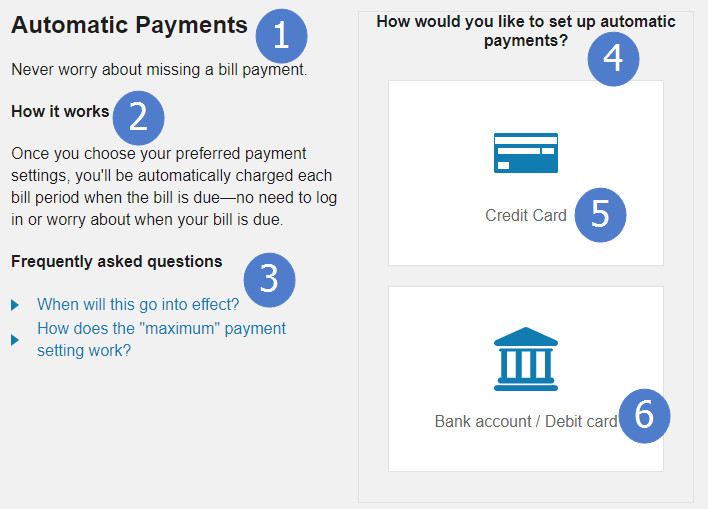
Use the table below to review all available configuration options.
| Image Number | Configuration Option |
|---|---|
| Not Depicted |
Disable Automatic Payments Enrollment Automatic payment enrollment can be hidden from Manage Billing Configuration Options if the utility does not want to offer this program to customers. Default: Enable Automatic Payment Enrollment |
| Not Depicted |
Disable Enrollment Methods You can define if credit cards and bank accounts are eligible methods for automatic payments. Default: Credit card and bank accounts are both eligible |
| 1 |
Title Default: Automatic Payments |
| 1 |
Explanation Default: Never worry about missing a bill payment. |
| 2 |
How it Works Section Title Default: How it works |
| 2 |
How it Works Description Default: Once you choose your preferred payment settings, you'll be automatically charged each bill period when the bill is due—no need to log in or worry about when your bill is due. |
| 3 |
Frequently Asked Questions Title Default: Frequently asked questions |
| 3 |
Frequently Asked Question and Answer 1 Default: When will this go into effect? Your automatic payment settings will be applied to your next bill. How does the “maximum” payment setting work? If an unexpectedly high bill comes along, you won't be charged higher than the "Maximum" amount. |
| 3 |
Frequently Asked Question and Answer 2 Default: How does the “maximum” payment setting work? If an unexpectedly high bill comes along, you won't be charged higher than the "Maximum" amount. |
| 4 |
Enrollment Section Title Default: How would you like to set up automatic payments? |
| 5 |
Credit Card Enrollment To support credit card payments, you must select a third-party payment provider to process credit card payments. Default: Credit card payments are disabled |
| 6 |
Bank Account or Debit Card Enrollment Payment processing using bank accounts or debit cards can be implemented through Oracle Utilities or a third-party payment provider. You must notify Oracle Utilities if all payment processing is implemented through a third-party payment provider. Default: Payments using bank accounts or debit cards are processed using Customer Care and Billing or other applicable Oracle Utilities product. |
| Not Depicted |
Third-Party Payment Processing Title If all automatic payments are supported through the third-party payment vendor Paymentus, the enrollment area references the Paymentus site to complete all automatic payment enrollment. Default: Automatic payments are powered by Paymentus |
| Not Depicted |
Third-Party Payment Processing Message If all automatic payments are supported through the third-party payment vendor Paymentus, the enrollment area references the Paymentus site to complete all automatic payment enrollment. Default: On the Paymentus site, you can enroll using either your bank account or credit card. |
| Not Depicted |
Disable Maximum Payment Amount Maximum payment amounts allow customers to define a maximum value that an automatic payment can be. Default: Enable a maximum payment amount |
| Not Depicted |
Message for Enrollment Errors A contact support message is displayed when a customer's enrollment attempt for automatic payments fails. Default:
|
Payment Arrangement Configuration Options
The following image shows a standard example of Payment Arrangement.
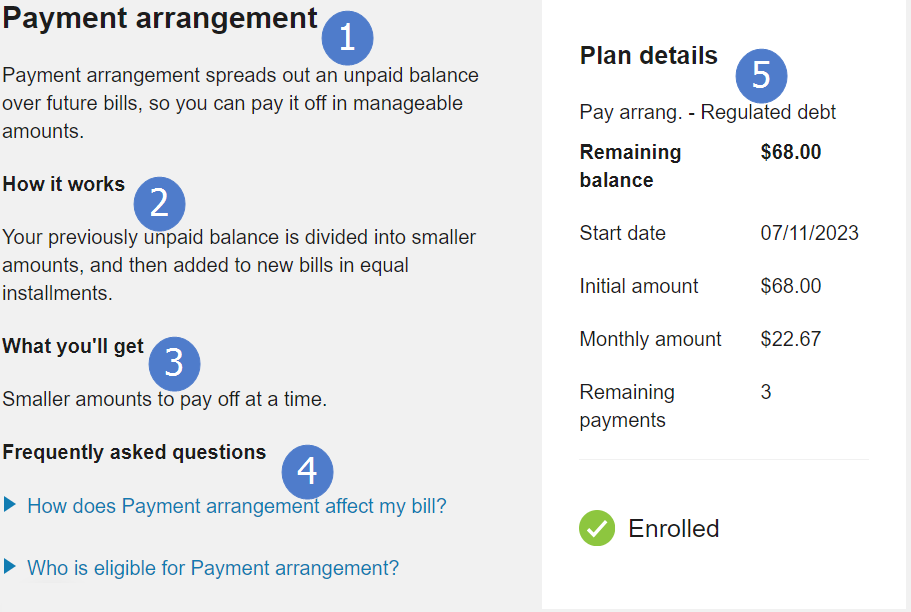
Use the table below to review all available configuration options.
Note: In addition to the required information listed below, Payment Arrangement requires a utility name, utility customer support email address, and utility customer support telephone number. Utilities provide these inputs as part of the Oracle Utilities Opower Platform Configuration Guide.
| Image Number | Configuration Option |
|---|---|
| Not Depicted |
Disable Payment Arrangement Programs Payment arrangement programs can be hidden from Manage Billing Configuration Options if the utility does not want to offer these programs to customers. Default: Enable Payment Arrangement Programs |
| Not Depicted |
Disable Online Enrollment Customers can be required to call in to the applicable utility support contact to enroll in payment arrangement programs. Customers can view their active payment arrangement if they are enrolled, but online enrollment is disabled. Default: Enable Online Enrollment |
| 1 |
Title Default: Payment Arrangement |
| 1 |
Explanation Default: Payment arrangement spreads out an unpaid balance over future bills, so you can pay it off in manageable amounts. |
| 2 |
How it Works Section Title Default: How it works |
| 2 |
How it Works Section Description Default: Your previously unpaid balance is divided into smaller amounts, and then added to new bills in equal installments. |
| 3 |
Additional Details Section Title Default: What you’ll get |
| 2 |
Additional Details Section Details Default:
|
| 4 |
Frequently Asked Questions Title Default: Frequently asked questions |
| 4 |
Frequently Asked Question and Answer 1 Default: How does Payment arrangement affect my bill? Payment Arrangement add the payment amount you selected to your regular monthly bill. Because this increases your overall payment each month, it is important that you select the payment plan that fits within your budget. If you need help deciding what plan to choose, contact us at [PhoneNumber]. |
| 4 |
Frequently Asked Question and Answer 2 Default: Who is eligible for Payment arrangement? The general requirement for eligibility is:
However, we recognize that each situation is different. Contact us at [PhoneNumber] to discuss additional options. |
| Not Depicted |
Message for Ineligible Customers Customers who are ineligible to enroll in the program are displayed an applicable ineligibility message rather than an option to enroll. For information on how eligibility is defined, see the steps described at Payment Arrangements. Default: For more information, contact us at [UtilityEmailLink]. |
| 5 |
Display Service Agreement Type Information about the service agreement type can be displayed as part of the enrollment status in payment arrangements. This can provide additional context to customers and customer service representatives. Default: Hide service agreement type. |
| 5 |
Display Service Agreement Numbers The service agreement numbers can be displayed as part of the enrollment status in payment arrangements. This can provide additional context to customers and customer service representatives. Service agreement types must also be configured to be displayed to additionally display the service agreement numbers as well. Default: Hide service agreement numbers |
Budget Billing Configuration Options
The following image shows a standard example of Budget Billing.
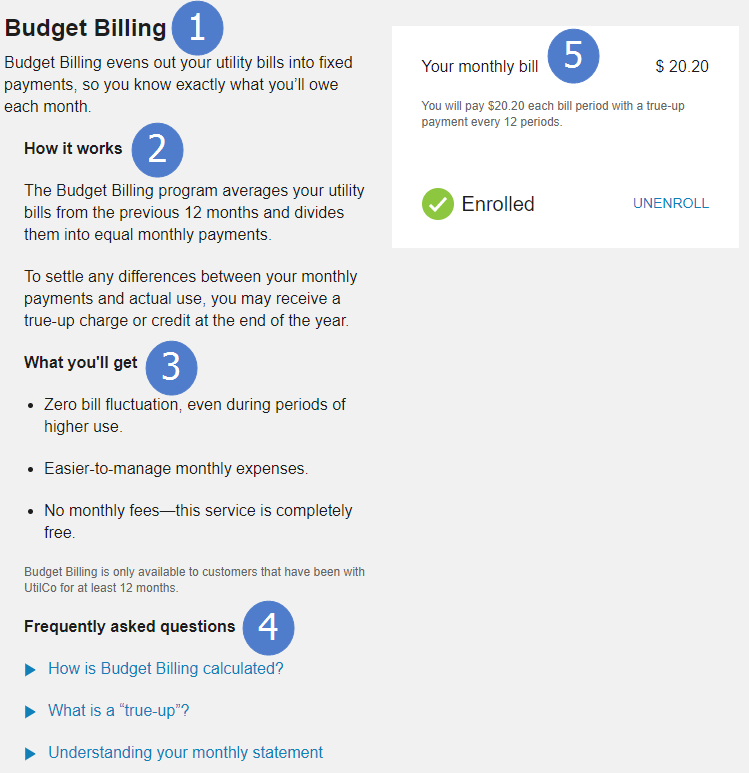
Use the table below to review all available configuration options.
| Image Number | Configuration Option |
|---|---|
| Not Depicted |
Disable Budget Billing Enrollment Budget billing enrollment can be hidden from Manage Billing Configuration Options if the utility does not want to offer this program to customers. Default: Enable Budget Billing Enrollment |
| 1 |
Title Default: Budget Billing |
| 1 |
Explanation Default: Budget Billing evens out your utility bills into fixed payments, so you know exactly what you’ll owe each month. |
| 2 |
How it Works Section Title Default: How it works |
| 2 |
How it Works Section Description Default: The Budget Billing program averages your utility bills from the previous 12 months and divides them into equal monthly payments. To settle any differences between your monthly payments and actual use, you may receive a true-up charge or credit at the end of the year. |
| 3 |
Additional Details Section Title Default: What you’ll get |
| 3 |
Additional Details Section Details Default:
Budget Billing is only available to customers that have been with [UtilityName] for at least 12 months. |
| 4 |
Frequently Asked Questions Default: How is Budget Billing calculated? Your Budget Billing amount is based on the average of your utility bills from the previous 12 months. We will continue to read your meter each month, and your monthly bill will show exactly how much you're using. At the end of the 12 month period, we will true-up your account so any differences between the estimated amount and actual usage can be settled. What is a “true-up”? A "true-up" is when we settle any differences between your Budget Billing amount and your actual usage. If you have a outstanding balance, you will receive a separate bill. If you have a credit, the amount will be applied to your next billing cycle. In addition to settling any differences, a new Budget Billing amount will be calculated based on your usage from the most current 12 months. This makes sure your Budget Billing amount reflects your actual usage as accurately as possible. Understanding your monthly statement Once enrolled in Budget Billing, your monthly bill will show three amounts: Budget Billing amount - your bill amount as a Budget Billing enrollee. Usage amount - what you would pay based on your actual usage. Deferred amount - the cumulative different between your usage amount and your Budget Billing amount. Over the course of a year, your Deferred amount would increase or decrease, sometimes even showing a credit. This amount is used to recalculate your Budget Billing amount during true-up. |
| 5 |
Payment Section Title Default: Your monthly bill |
| 5 |
Payment Section Message Default: You will pay |
| Not Depicted |
Message for Ineligible Customers Customers who are ineligible to enroll in the program are displayed an applicable ineligibility message rather than an option to enroll. Default: For more information, contact us at [UtilityEmailLink]. |
Charity Contributions Configuration Options
The following image shows a standard example of Charity Contributions.
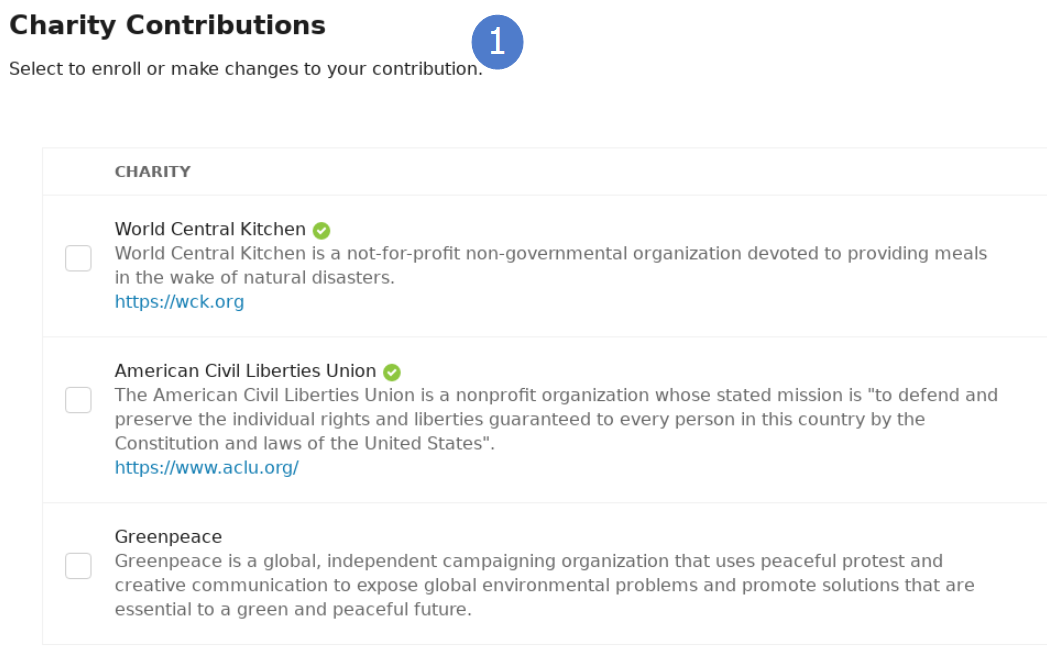
Use the table below to review all available configuration options.
| Image Number | Configuration Option |
|---|---|
| Not Depicted |
Enable Charity Contributions Enrollment Charity contribution enrollment can be enabled as part of Manage Billing Configuration Options if the utility wants to offer this program to customers. Default: Disable Charity Contributions |
| 1 |
Title Default: Charity Contributions |
| 1 |
Explanation Default: Select to enroll or make changes to your contribution. |
User Experience Variations
The user experience varies for customers depending upon their service types, available data, costs, and locale. Note that the following list indicates the primary user experience variations, not all possible variations.
- All Automatic Payments Through Paymentus: If the third-party payment vendor Paymentus is configured to handle all automatic payments, customers are provided a message automatic payment enrollment through the Paymentus site.
- Automatic Payment Methods: Utilities can configure which methods are allowed for automatic payment enrollment. If only a single method is enabled, the customer is shown the single applicable method rather than being presented a choice between credit card and bank account.
- Ineligible Customers: Customers who are ineligible to enroll in programs including budget billing, automatic payments, and payment arrangements are displayed an applicable ineligibility message rather than an option to enroll.
Payment Extensions Configuration Options
The following image shows a standard example of Payment Extensions.
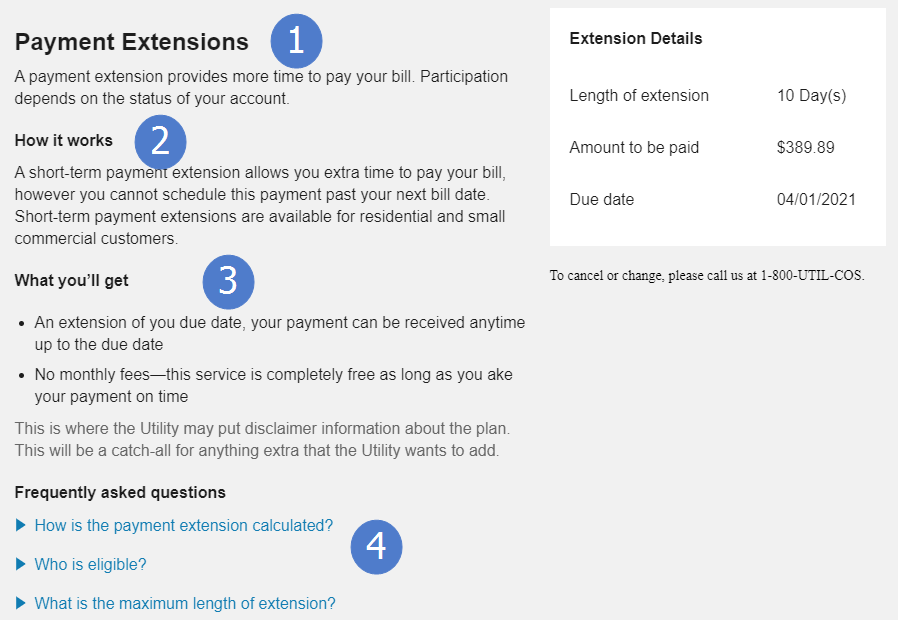
Use the table below to review all available configuration options.
| Image Number | Configuration Option |
|---|---|
| Not Depicted |
Enable Payment Extension Enrollment Payment Extension enrollment can be enabled as part of Manage Billing Configuration Options if the utility wants to offer this program to customers. If Payment Extension is enabled, complete all payment extension configurations, as described at Payment Extensions. Default: Disable Payment Extensions |
| 1 |
Title Default: Payment Extensions |
| 1 |
Explanation Default: A payment extension provides more time to pay your bill. Participation depends on the status of your account. |
| 2 |
How it Works Section Title Default: How it works |
| 2 |
How it Works Description Default: A short-term payment extension allows you extra time to pay your bill, however you cannot schedule this payment past your next bill date. Short-term payment extensions are available for residential and small commercial customers. |
| 3 |
What You'll Get Section Title Default: What You'll Get |
| 3 |
What You'll Get Section Description Default:
|
| 4 |
Frequently Asked Questions Default: How is the payment extension calculated? The Payment Extension option is a short-term extension of the due date for the full payment of your past-due balance. Who is eligible? Payment extensions are only available for residential customers. What is the maximum length of extension? Payment extensions can only be granted for a maximum of two (2) weeks from date of arrangement. |
Preferred Payment Date Configuration Options
The following image shows a standard example of Preferred Payment Date enrollment.
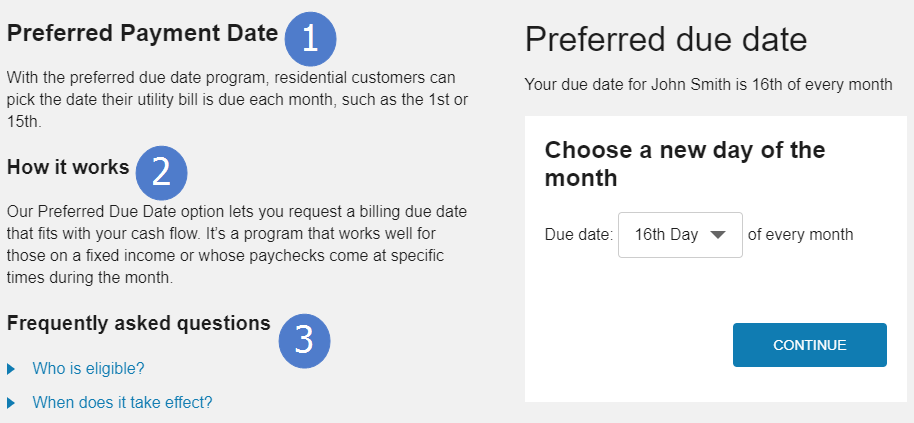
Use the table below to review all available configuration options.
| Image Number | Configuration Option |
|---|---|
| Not Depicted |
Enable Preferred Payment Date Enrollment Preferred Payment Date enrollment can be enabled as part of Manage Billing Configuration Options if the utility wants to offer this program to customers. Default: Disable Preferred Payment Date |
| 1 |
Title Default: Preferred Payment Date |
| 1 |
Explanation Default: With the preferred due date program, residential customers can pick the date their utility bill is due each month, such as the 1st or 15th. |
| 2 |
How it Works Section Title Default: How it works |
| 2 |
How it Works Description Default: Our Preferred Due Date option lets you request a billing due date that fits with your cash flow. It’s a program that works well for those on a fixed income or whose paychecks come at specific times during the month. |
| 3 |
Frequently Asked Questions Default: Who is eligible? You must be current on your account (zero balance). Customers with an active payment arrangements or other payment programs who are current on their accounts are also eligible. When does it take effect? When you switch to Preferred Due Date, your first bill will cover either a longer or shorter time period to allow for the schedule adjustment, and therefore may be a little higher or lower than your typical bill. |